Management Innovation and Entrepreneurship of Hospitality Report
VerifiedAdded on 2022/10/04
|10
|2642
|453
Report
AI Summary
This report examines innovation and entrepreneurship within the Hospitality and Tourism (HT) industry, focusing on the Applied Creativity and Innovation (ACI) model. The report uses Grand-Hyatt as a case study to illustrate the ACI model's application, particularly within the customer service department. It outlines the evolution of the HT industry and the changes driven by technological and demographic shifts. The report details the five key elements of the ACI model: defining the challenge, exploring the situation, ideation, designing solutions, and implementing solutions. It highlights how Grand-Hyatt can apply the ACI model to address negative customer feedback, proposing solutions such as increased franchising and customer loyalty programs. The report concludes by emphasizing the importance of creativity, critical thinking, and innovation for organizational growth in the hospitality sector.
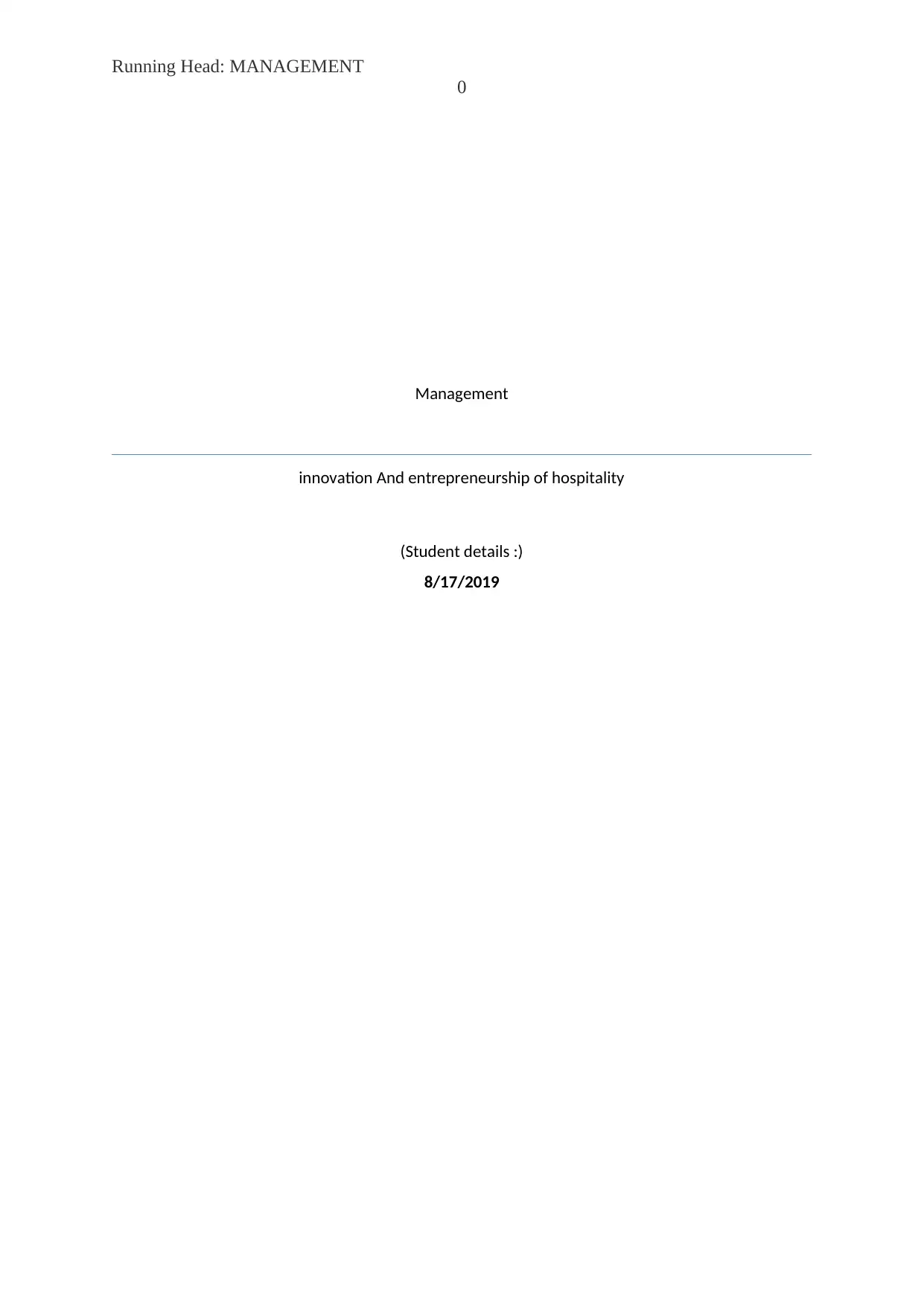
Running Head: MANAGEMENT
0
Management
innovation And entrepreneurship of hospitality
(Student details :)
8/17/2019
0
Management
innovation And entrepreneurship of hospitality
(Student details :)
8/17/2019
Paraphrase This Document
Need a fresh take? Get an instant paraphrase of this document with our AI Paraphraser
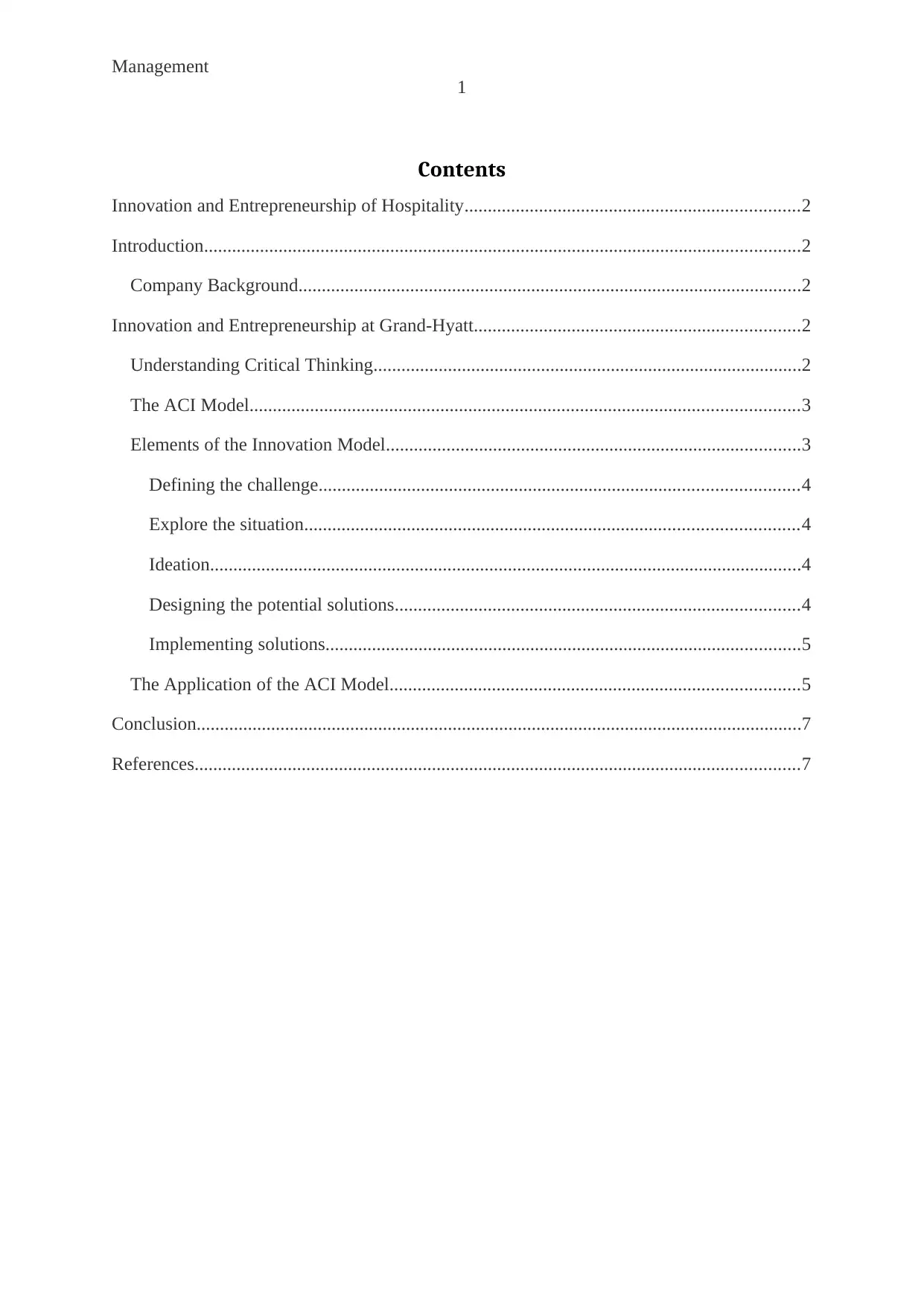
Management
1
Contents
Innovation and Entrepreneurship of Hospitality........................................................................2
Introduction................................................................................................................................2
Company Background............................................................................................................2
Innovation and Entrepreneurship at Grand-Hyatt......................................................................2
Understanding Critical Thinking............................................................................................2
The ACI Model......................................................................................................................3
Elements of the Innovation Model.........................................................................................3
Defining the challenge.......................................................................................................4
Explore the situation..........................................................................................................4
Ideation...............................................................................................................................4
Designing the potential solutions.......................................................................................4
Implementing solutions......................................................................................................5
The Application of the ACI Model........................................................................................5
Conclusion..................................................................................................................................7
References..................................................................................................................................7
1
Contents
Innovation and Entrepreneurship of Hospitality........................................................................2
Introduction................................................................................................................................2
Company Background............................................................................................................2
Innovation and Entrepreneurship at Grand-Hyatt......................................................................2
Understanding Critical Thinking............................................................................................2
The ACI Model......................................................................................................................3
Elements of the Innovation Model.........................................................................................3
Defining the challenge.......................................................................................................4
Explore the situation..........................................................................................................4
Ideation...............................................................................................................................4
Designing the potential solutions.......................................................................................4
Implementing solutions......................................................................................................5
The Application of the ACI Model........................................................................................5
Conclusion..................................................................................................................................7
References..................................................................................................................................7
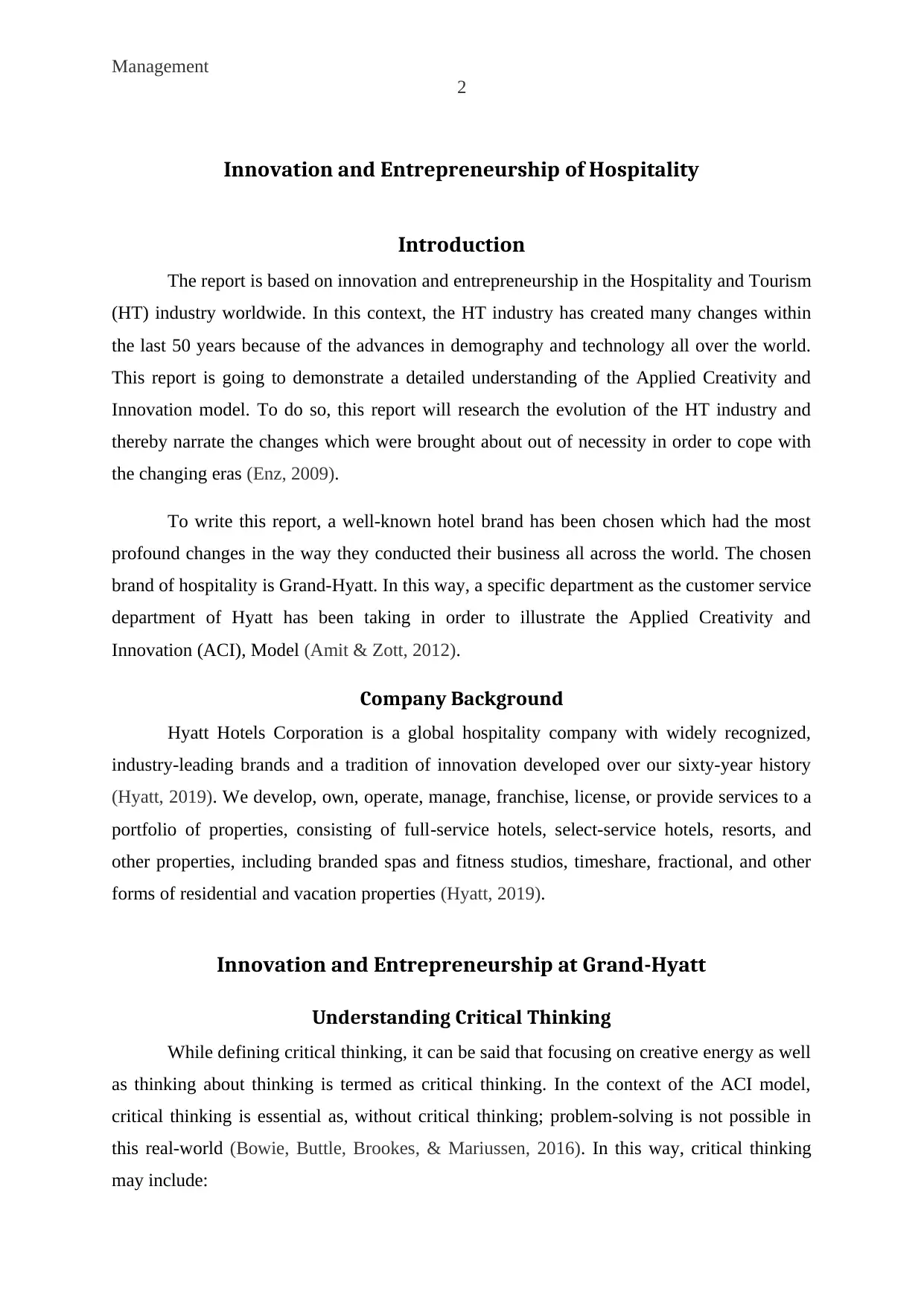
Management
2
Innovation and Entrepreneurship of Hospitality
Introduction
The report is based on innovation and entrepreneurship in the Hospitality and Tourism
(HT) industry worldwide. In this context, the HT industry has created many changes within
the last 50 years because of the advances in demography and technology all over the world.
This report is going to demonstrate a detailed understanding of the Applied Creativity and
Innovation model. To do so, this report will research the evolution of the HT industry and
thereby narrate the changes which were brought about out of necessity in order to cope with
the changing eras (Enz, 2009).
To write this report, a well-known hotel brand has been chosen which had the most
profound changes in the way they conducted their business all across the world. The chosen
brand of hospitality is Grand-Hyatt. In this way, a specific department as the customer service
department of Hyatt has been taking in order to illustrate the Applied Creativity and
Innovation (ACI), Model (Amit & Zott, 2012).
Company Background
Hyatt Hotels Corporation is a global hospitality company with widely recognized,
industry-leading brands and a tradition of innovation developed over our sixty-year history
(Hyatt, 2019). We develop, own, operate, manage, franchise, license, or provide services to a
portfolio of properties, consisting of full-service hotels, select-service hotels, resorts, and
other properties, including branded spas and fitness studios, timeshare, fractional, and other
forms of residential and vacation properties (Hyatt, 2019).
Innovation and Entrepreneurship at Grand-Hyatt
Understanding Critical Thinking
While defining critical thinking, it can be said that focusing on creative energy as well
as thinking about thinking is termed as critical thinking. In the context of the ACI model,
critical thinking is essential as, without critical thinking; problem-solving is not possible in
this real-world (Bowie, Buttle, Brookes, & Mariussen, 2016). In this way, critical thinking
may include:
2
Innovation and Entrepreneurship of Hospitality
Introduction
The report is based on innovation and entrepreneurship in the Hospitality and Tourism
(HT) industry worldwide. In this context, the HT industry has created many changes within
the last 50 years because of the advances in demography and technology all over the world.
This report is going to demonstrate a detailed understanding of the Applied Creativity and
Innovation model. To do so, this report will research the evolution of the HT industry and
thereby narrate the changes which were brought about out of necessity in order to cope with
the changing eras (Enz, 2009).
To write this report, a well-known hotel brand has been chosen which had the most
profound changes in the way they conducted their business all across the world. The chosen
brand of hospitality is Grand-Hyatt. In this way, a specific department as the customer service
department of Hyatt has been taking in order to illustrate the Applied Creativity and
Innovation (ACI), Model (Amit & Zott, 2012).
Company Background
Hyatt Hotels Corporation is a global hospitality company with widely recognized,
industry-leading brands and a tradition of innovation developed over our sixty-year history
(Hyatt, 2019). We develop, own, operate, manage, franchise, license, or provide services to a
portfolio of properties, consisting of full-service hotels, select-service hotels, resorts, and
other properties, including branded spas and fitness studios, timeshare, fractional, and other
forms of residential and vacation properties (Hyatt, 2019).
Innovation and Entrepreneurship at Grand-Hyatt
Understanding Critical Thinking
While defining critical thinking, it can be said that focusing on creative energy as well
as thinking about thinking is termed as critical thinking. In the context of the ACI model,
critical thinking is essential as, without critical thinking; problem-solving is not possible in
this real-world (Bowie, Buttle, Brookes, & Mariussen, 2016). In this way, critical thinking
may include:
⊘ This is a preview!⊘
Do you want full access?
Subscribe today to unlock all pages.

Trusted by 1+ million students worldwide
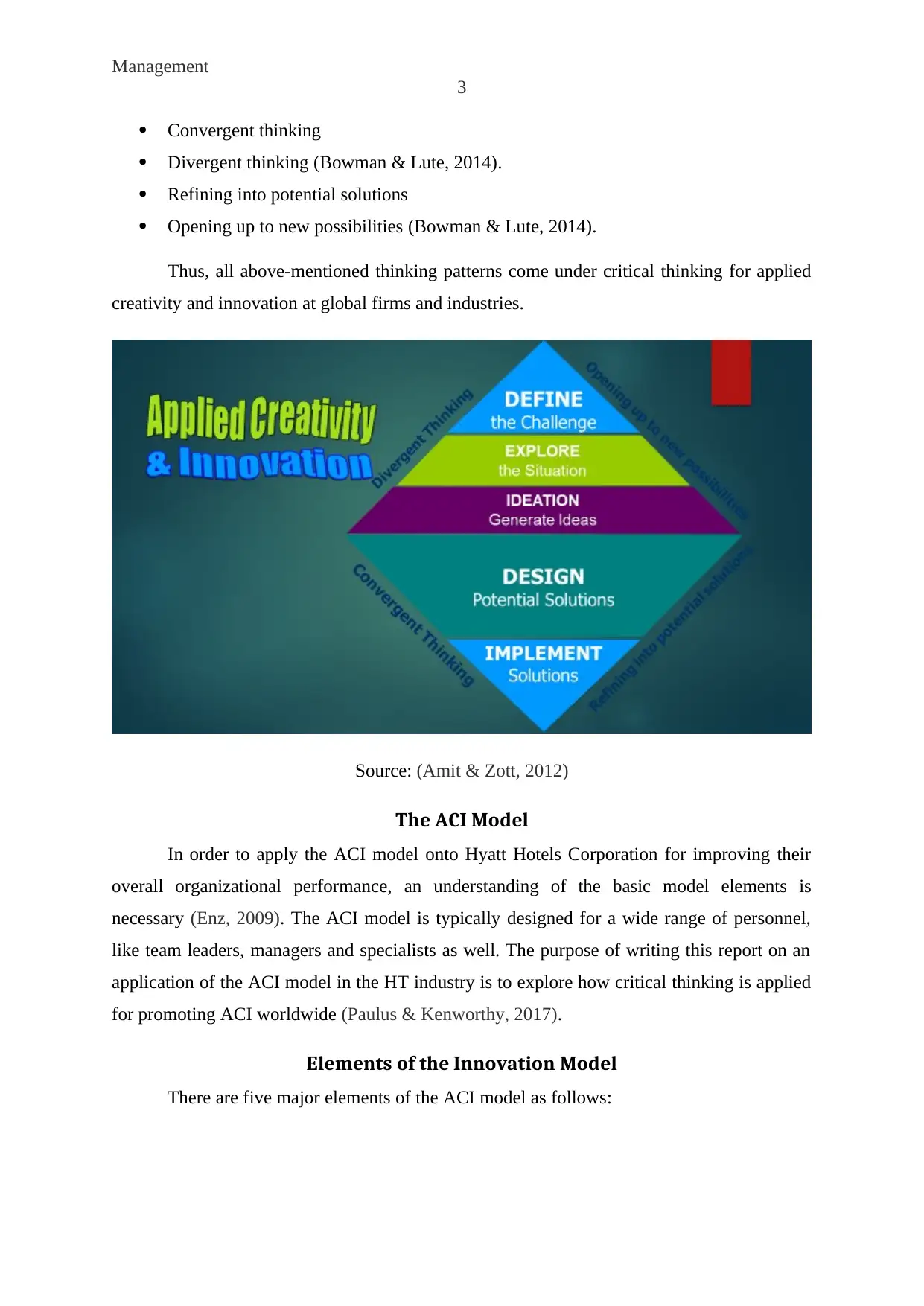
Management
3
Convergent thinking
Divergent thinking (Bowman & Lute, 2014).
Refining into potential solutions
Opening up to new possibilities (Bowman & Lute, 2014).
Thus, all above-mentioned thinking patterns come under critical thinking for applied
creativity and innovation at global firms and industries.
Source: (Amit & Zott, 2012)
The ACI Model
In order to apply the ACI model onto Hyatt Hotels Corporation for improving their
overall organizational performance, an understanding of the basic model elements is
necessary (Enz, 2009). The ACI model is typically designed for a wide range of personnel,
like team leaders, managers and specialists as well. The purpose of writing this report on an
application of the ACI model in the HT industry is to explore how critical thinking is applied
for promoting ACI worldwide (Paulus & Kenworthy, 2017).
Elements of the Innovation Model
There are five major elements of the ACI model as follows:
3
Convergent thinking
Divergent thinking (Bowman & Lute, 2014).
Refining into potential solutions
Opening up to new possibilities (Bowman & Lute, 2014).
Thus, all above-mentioned thinking patterns come under critical thinking for applied
creativity and innovation at global firms and industries.
Source: (Amit & Zott, 2012)
The ACI Model
In order to apply the ACI model onto Hyatt Hotels Corporation for improving their
overall organizational performance, an understanding of the basic model elements is
necessary (Enz, 2009). The ACI model is typically designed for a wide range of personnel,
like team leaders, managers and specialists as well. The purpose of writing this report on an
application of the ACI model in the HT industry is to explore how critical thinking is applied
for promoting ACI worldwide (Paulus & Kenworthy, 2017).
Elements of the Innovation Model
There are five major elements of the ACI model as follows:
Paraphrase This Document
Need a fresh take? Get an instant paraphrase of this document with our AI Paraphraser
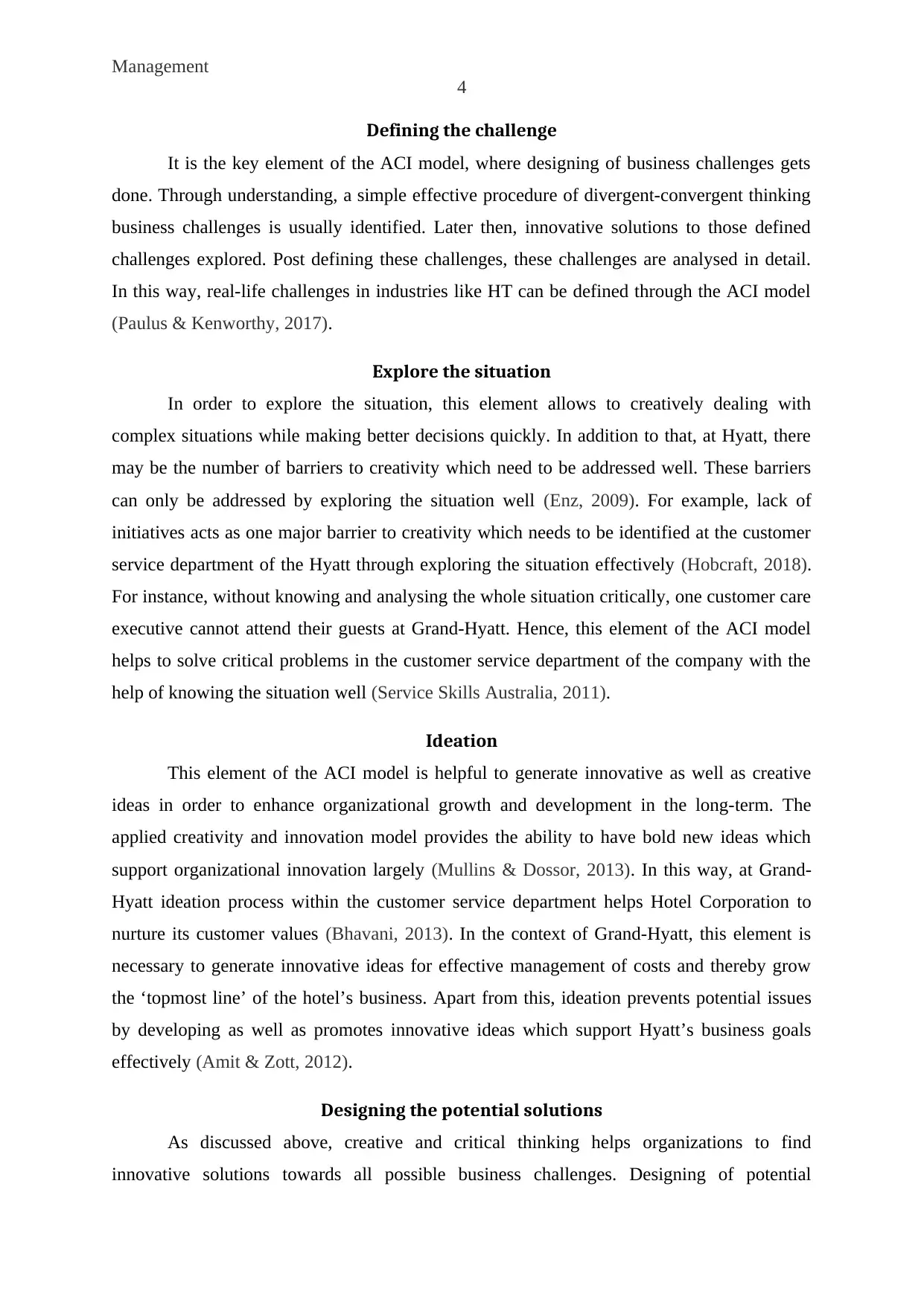
Management
4
Defining the challenge
It is the key element of the ACI model, where designing of business challenges gets
done. Through understanding, a simple effective procedure of divergent-convergent thinking
business challenges is usually identified. Later then, innovative solutions to those defined
challenges explored. Post defining these challenges, these challenges are analysed in detail.
In this way, real-life challenges in industries like HT can be defined through the ACI model
(Paulus & Kenworthy, 2017).
Explore the situation
In order to explore the situation, this element allows to creatively dealing with
complex situations while making better decisions quickly. In addition to that, at Hyatt, there
may be the number of barriers to creativity which need to be addressed well. These barriers
can only be addressed by exploring the situation well (Enz, 2009). For example, lack of
initiatives acts as one major barrier to creativity which needs to be identified at the customer
service department of the Hyatt through exploring the situation effectively (Hobcraft, 2018).
For instance, without knowing and analysing the whole situation critically, one customer care
executive cannot attend their guests at Grand-Hyatt. Hence, this element of the ACI model
helps to solve critical problems in the customer service department of the company with the
help of knowing the situation well (Service Skills Australia, 2011).
Ideation
This element of the ACI model is helpful to generate innovative as well as creative
ideas in order to enhance organizational growth and development in the long-term. The
applied creativity and innovation model provides the ability to have bold new ideas which
support organizational innovation largely (Mullins & Dossor, 2013). In this way, at Grand-
Hyatt ideation process within the customer service department helps Hotel Corporation to
nurture its customer values (Bhavani, 2013). In the context of Grand-Hyatt, this element is
necessary to generate innovative ideas for effective management of costs and thereby grow
the ‘topmost line’ of the hotel’s business. Apart from this, ideation prevents potential issues
by developing as well as promotes innovative ideas which support Hyatt’s business goals
effectively (Amit & Zott, 2012).
Designing the potential solutions
As discussed above, creative and critical thinking helps organizations to find
innovative solutions towards all possible business challenges. Designing of potential
4
Defining the challenge
It is the key element of the ACI model, where designing of business challenges gets
done. Through understanding, a simple effective procedure of divergent-convergent thinking
business challenges is usually identified. Later then, innovative solutions to those defined
challenges explored. Post defining these challenges, these challenges are analysed in detail.
In this way, real-life challenges in industries like HT can be defined through the ACI model
(Paulus & Kenworthy, 2017).
Explore the situation
In order to explore the situation, this element allows to creatively dealing with
complex situations while making better decisions quickly. In addition to that, at Hyatt, there
may be the number of barriers to creativity which need to be addressed well. These barriers
can only be addressed by exploring the situation well (Enz, 2009). For example, lack of
initiatives acts as one major barrier to creativity which needs to be identified at the customer
service department of the Hyatt through exploring the situation effectively (Hobcraft, 2018).
For instance, without knowing and analysing the whole situation critically, one customer care
executive cannot attend their guests at Grand-Hyatt. Hence, this element of the ACI model
helps to solve critical problems in the customer service department of the company with the
help of knowing the situation well (Service Skills Australia, 2011).
Ideation
This element of the ACI model is helpful to generate innovative as well as creative
ideas in order to enhance organizational growth and development in the long-term. The
applied creativity and innovation model provides the ability to have bold new ideas which
support organizational innovation largely (Mullins & Dossor, 2013). In this way, at Grand-
Hyatt ideation process within the customer service department helps Hotel Corporation to
nurture its customer values (Bhavani, 2013). In the context of Grand-Hyatt, this element is
necessary to generate innovative ideas for effective management of costs and thereby grow
the ‘topmost line’ of the hotel’s business. Apart from this, ideation prevents potential issues
by developing as well as promotes innovative ideas which support Hyatt’s business goals
effectively (Amit & Zott, 2012).
Designing the potential solutions
As discussed above, creative and critical thinking helps organizations to find
innovative solutions towards all possible business challenges. Designing of potential
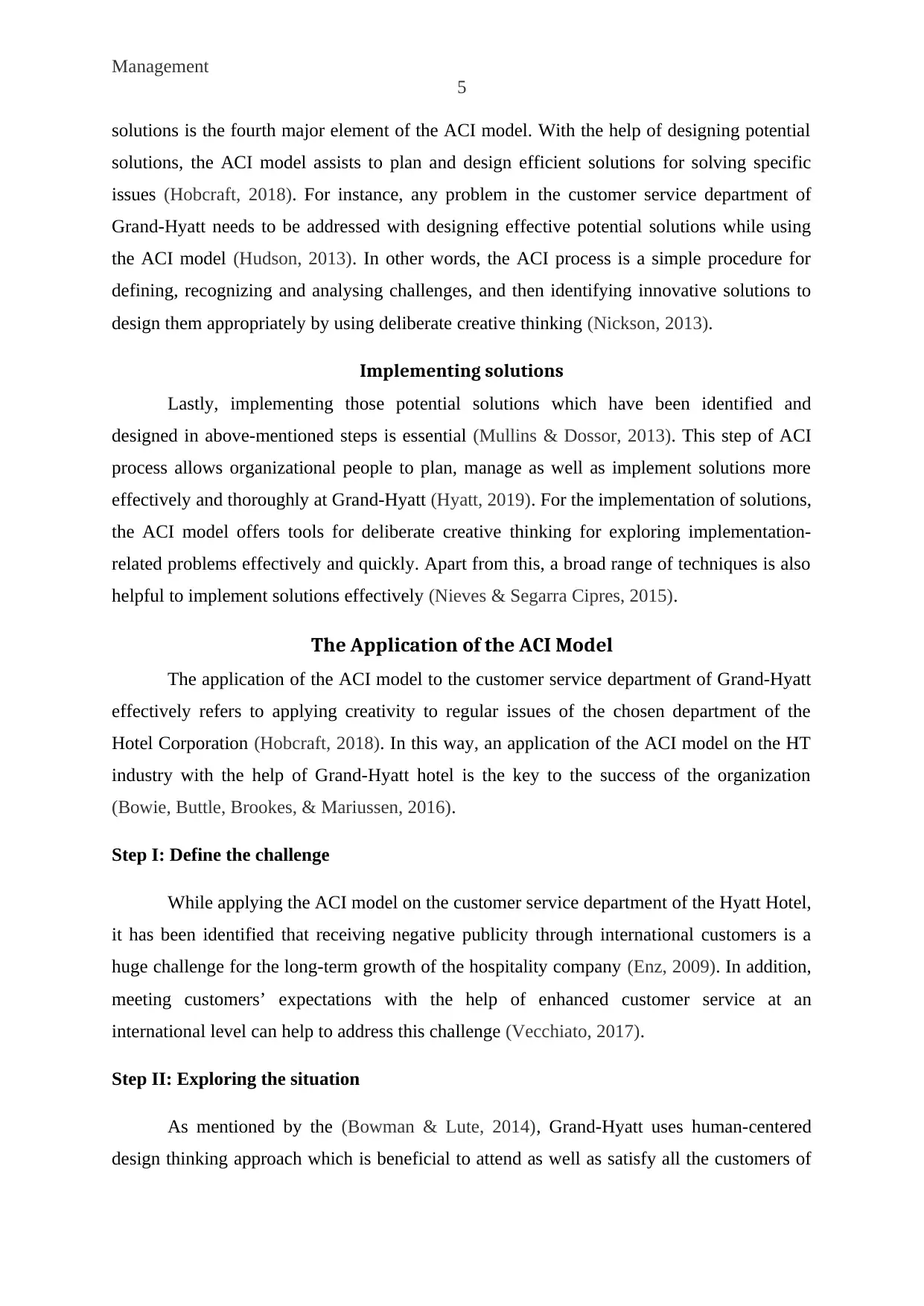
Management
5
solutions is the fourth major element of the ACI model. With the help of designing potential
solutions, the ACI model assists to plan and design efficient solutions for solving specific
issues (Hobcraft, 2018). For instance, any problem in the customer service department of
Grand-Hyatt needs to be addressed with designing effective potential solutions while using
the ACI model (Hudson, 2013). In other words, the ACI process is a simple procedure for
defining, recognizing and analysing challenges, and then identifying innovative solutions to
design them appropriately by using deliberate creative thinking (Nickson, 2013).
Implementing solutions
Lastly, implementing those potential solutions which have been identified and
designed in above-mentioned steps is essential (Mullins & Dossor, 2013). This step of ACI
process allows organizational people to plan, manage as well as implement solutions more
effectively and thoroughly at Grand-Hyatt (Hyatt, 2019). For the implementation of solutions,
the ACI model offers tools for deliberate creative thinking for exploring implementation-
related problems effectively and quickly. Apart from this, a broad range of techniques is also
helpful to implement solutions effectively (Nieves & Segarra Cipres, 2015).
The Application of the ACI Model
The application of the ACI model to the customer service department of Grand-Hyatt
effectively refers to applying creativity to regular issues of the chosen department of the
Hotel Corporation (Hobcraft, 2018). In this way, an application of the ACI model on the HT
industry with the help of Grand-Hyatt hotel is the key to the success of the organization
(Bowie, Buttle, Brookes, & Mariussen, 2016).
Step I: Define the challenge
While applying the ACI model on the customer service department of the Hyatt Hotel,
it has been identified that receiving negative publicity through international customers is a
huge challenge for the long-term growth of the hospitality company (Enz, 2009). In addition,
meeting customers’ expectations with the help of enhanced customer service at an
international level can help to address this challenge (Vecchiato, 2017).
Step II: Exploring the situation
As mentioned by the (Bowman & Lute, 2014), Grand-Hyatt uses human-centered
design thinking approach which is beneficial to attend as well as satisfy all the customers of
5
solutions is the fourth major element of the ACI model. With the help of designing potential
solutions, the ACI model assists to plan and design efficient solutions for solving specific
issues (Hobcraft, 2018). For instance, any problem in the customer service department of
Grand-Hyatt needs to be addressed with designing effective potential solutions while using
the ACI model (Hudson, 2013). In other words, the ACI process is a simple procedure for
defining, recognizing and analysing challenges, and then identifying innovative solutions to
design them appropriately by using deliberate creative thinking (Nickson, 2013).
Implementing solutions
Lastly, implementing those potential solutions which have been identified and
designed in above-mentioned steps is essential (Mullins & Dossor, 2013). This step of ACI
process allows organizational people to plan, manage as well as implement solutions more
effectively and thoroughly at Grand-Hyatt (Hyatt, 2019). For the implementation of solutions,
the ACI model offers tools for deliberate creative thinking for exploring implementation-
related problems effectively and quickly. Apart from this, a broad range of techniques is also
helpful to implement solutions effectively (Nieves & Segarra Cipres, 2015).
The Application of the ACI Model
The application of the ACI model to the customer service department of Grand-Hyatt
effectively refers to applying creativity to regular issues of the chosen department of the
Hotel Corporation (Hobcraft, 2018). In this way, an application of the ACI model on the HT
industry with the help of Grand-Hyatt hotel is the key to the success of the organization
(Bowie, Buttle, Brookes, & Mariussen, 2016).
Step I: Define the challenge
While applying the ACI model on the customer service department of the Hyatt Hotel,
it has been identified that receiving negative publicity through international customers is a
huge challenge for the long-term growth of the hospitality company (Enz, 2009). In addition,
meeting customers’ expectations with the help of enhanced customer service at an
international level can help to address this challenge (Vecchiato, 2017).
Step II: Exploring the situation
As mentioned by the (Bowman & Lute, 2014), Grand-Hyatt uses human-centered
design thinking approach which is beneficial to attend as well as satisfy all the customers of
⊘ This is a preview!⊘
Do you want full access?
Subscribe today to unlock all pages.

Trusted by 1+ million students worldwide
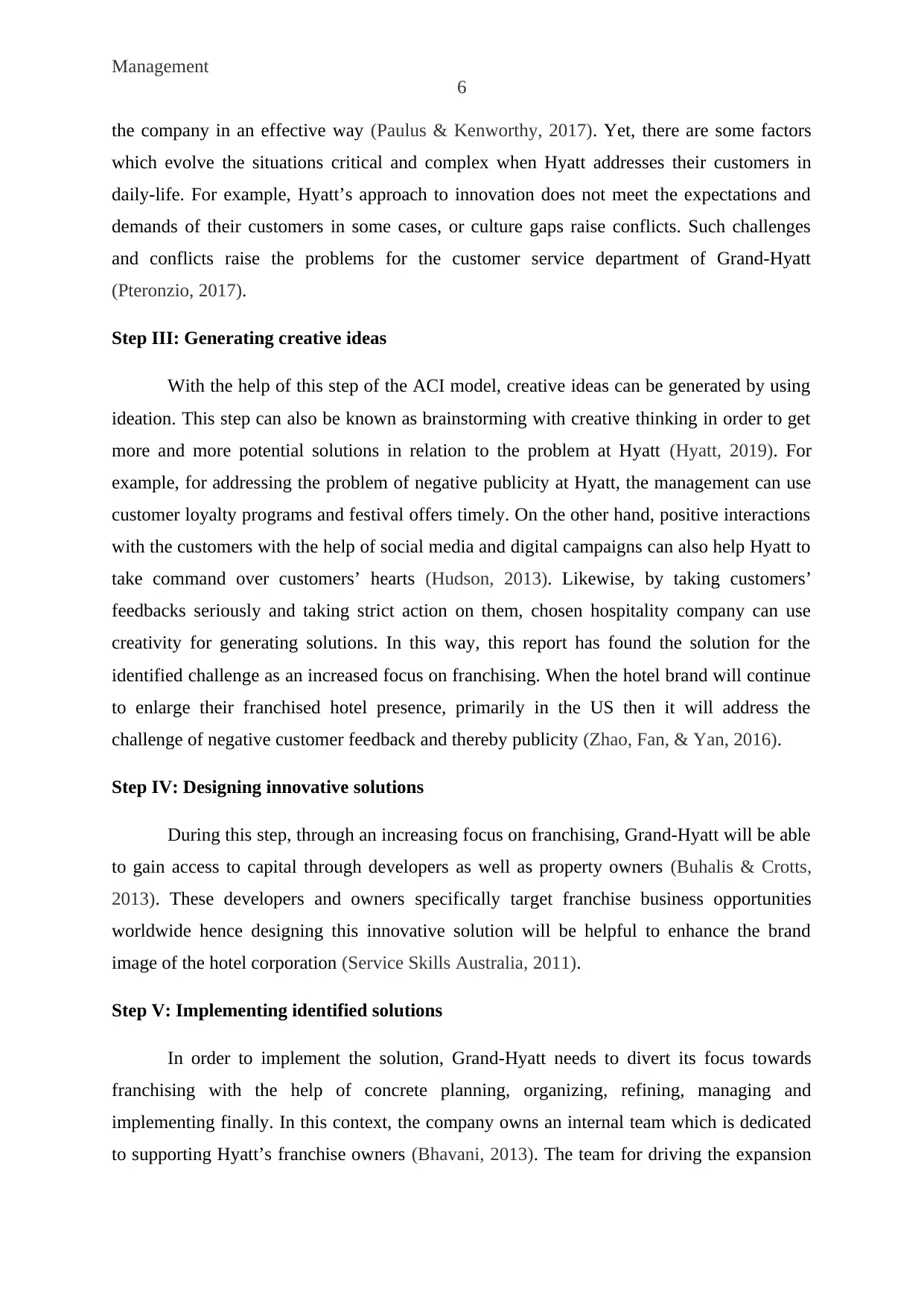
Management
6
the company in an effective way (Paulus & Kenworthy, 2017). Yet, there are some factors
which evolve the situations critical and complex when Hyatt addresses their customers in
daily-life. For example, Hyatt’s approach to innovation does not meet the expectations and
demands of their customers in some cases, or culture gaps raise conflicts. Such challenges
and conflicts raise the problems for the customer service department of Grand-Hyatt
(Pteronzio, 2017).
Step III: Generating creative ideas
With the help of this step of the ACI model, creative ideas can be generated by using
ideation. This step can also be known as brainstorming with creative thinking in order to get
more and more potential solutions in relation to the problem at Hyatt (Hyatt, 2019). For
example, for addressing the problem of negative publicity at Hyatt, the management can use
customer loyalty programs and festival offers timely. On the other hand, positive interactions
with the customers with the help of social media and digital campaigns can also help Hyatt to
take command over customers’ hearts (Hudson, 2013). Likewise, by taking customers’
feedbacks seriously and taking strict action on them, chosen hospitality company can use
creativity for generating solutions. In this way, this report has found the solution for the
identified challenge as an increased focus on franchising. When the hotel brand will continue
to enlarge their franchised hotel presence, primarily in the US then it will address the
challenge of negative customer feedback and thereby publicity (Zhao, Fan, & Yan, 2016).
Step IV: Designing innovative solutions
During this step, through an increasing focus on franchising, Grand-Hyatt will be able
to gain access to capital through developers as well as property owners (Buhalis & Crotts,
2013). These developers and owners specifically target franchise business opportunities
worldwide hence designing this innovative solution will be helpful to enhance the brand
image of the hotel corporation (Service Skills Australia, 2011).
Step V: Implementing identified solutions
In order to implement the solution, Grand-Hyatt needs to divert its focus towards
franchising with the help of concrete planning, organizing, refining, managing and
implementing finally. In this context, the company owns an internal team which is dedicated
to supporting Hyatt’s franchise owners (Bhavani, 2013). The team for driving the expansion
6
the company in an effective way (Paulus & Kenworthy, 2017). Yet, there are some factors
which evolve the situations critical and complex when Hyatt addresses their customers in
daily-life. For example, Hyatt’s approach to innovation does not meet the expectations and
demands of their customers in some cases, or culture gaps raise conflicts. Such challenges
and conflicts raise the problems for the customer service department of Grand-Hyatt
(Pteronzio, 2017).
Step III: Generating creative ideas
With the help of this step of the ACI model, creative ideas can be generated by using
ideation. This step can also be known as brainstorming with creative thinking in order to get
more and more potential solutions in relation to the problem at Hyatt (Hyatt, 2019). For
example, for addressing the problem of negative publicity at Hyatt, the management can use
customer loyalty programs and festival offers timely. On the other hand, positive interactions
with the customers with the help of social media and digital campaigns can also help Hyatt to
take command over customers’ hearts (Hudson, 2013). Likewise, by taking customers’
feedbacks seriously and taking strict action on them, chosen hospitality company can use
creativity for generating solutions. In this way, this report has found the solution for the
identified challenge as an increased focus on franchising. When the hotel brand will continue
to enlarge their franchised hotel presence, primarily in the US then it will address the
challenge of negative customer feedback and thereby publicity (Zhao, Fan, & Yan, 2016).
Step IV: Designing innovative solutions
During this step, through an increasing focus on franchising, Grand-Hyatt will be able
to gain access to capital through developers as well as property owners (Buhalis & Crotts,
2013). These developers and owners specifically target franchise business opportunities
worldwide hence designing this innovative solution will be helpful to enhance the brand
image of the hotel corporation (Service Skills Australia, 2011).
Step V: Implementing identified solutions
In order to implement the solution, Grand-Hyatt needs to divert its focus towards
franchising with the help of concrete planning, organizing, refining, managing and
implementing finally. In this context, the company owns an internal team which is dedicated
to supporting Hyatt’s franchise owners (Bhavani, 2013). The team for driving the expansion
Paraphrase This Document
Need a fresh take? Get an instant paraphrase of this document with our AI Paraphraser
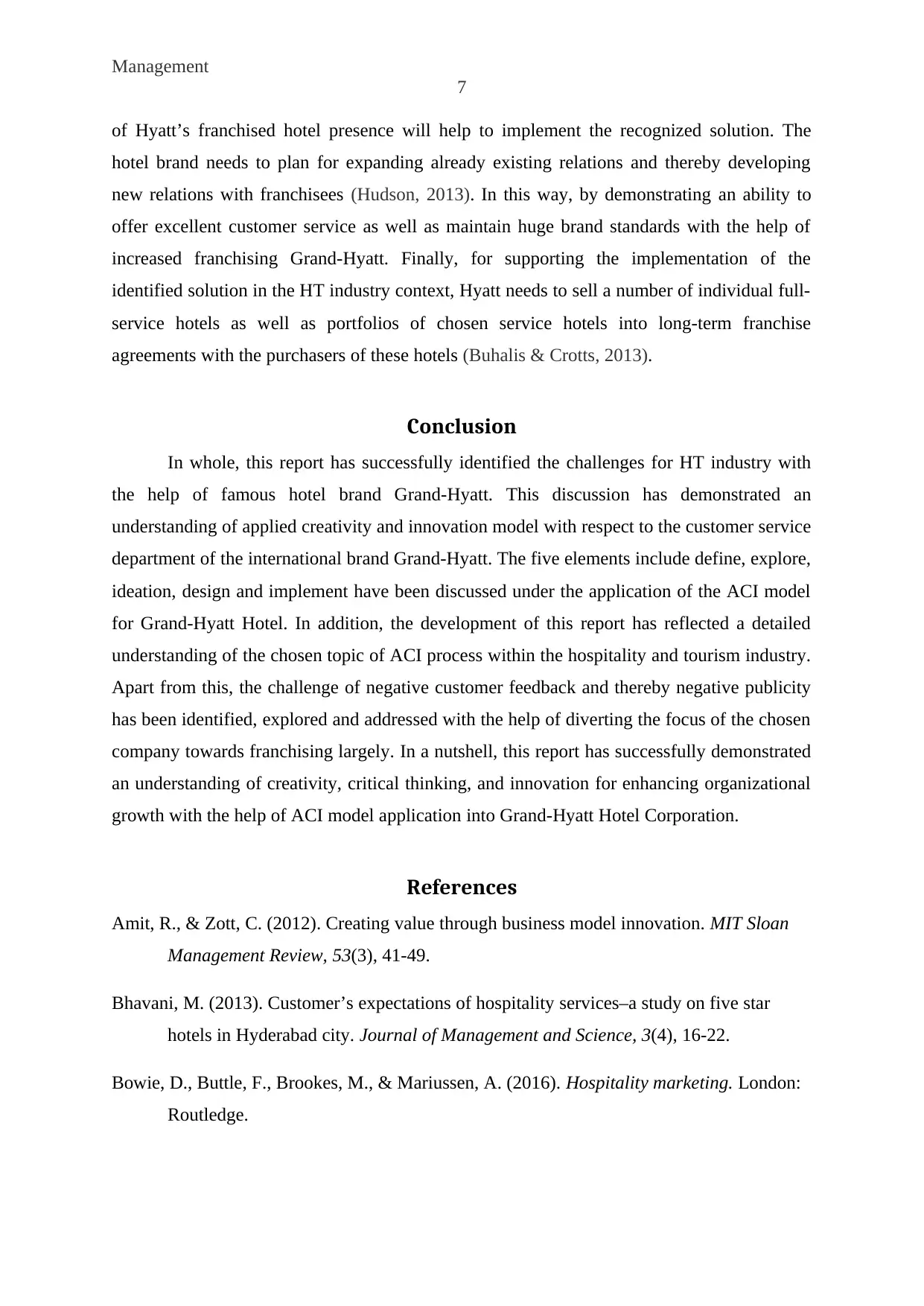
Management
7
of Hyatt’s franchised hotel presence will help to implement the recognized solution. The
hotel brand needs to plan for expanding already existing relations and thereby developing
new relations with franchisees (Hudson, 2013). In this way, by demonstrating an ability to
offer excellent customer service as well as maintain huge brand standards with the help of
increased franchising Grand-Hyatt. Finally, for supporting the implementation of the
identified solution in the HT industry context, Hyatt needs to sell a number of individual full-
service hotels as well as portfolios of chosen service hotels into long-term franchise
agreements with the purchasers of these hotels (Buhalis & Crotts, 2013).
Conclusion
In whole, this report has successfully identified the challenges for HT industry with
the help of famous hotel brand Grand-Hyatt. This discussion has demonstrated an
understanding of applied creativity and innovation model with respect to the customer service
department of the international brand Grand-Hyatt. The five elements include define, explore,
ideation, design and implement have been discussed under the application of the ACI model
for Grand-Hyatt Hotel. In addition, the development of this report has reflected a detailed
understanding of the chosen topic of ACI process within the hospitality and tourism industry.
Apart from this, the challenge of negative customer feedback and thereby negative publicity
has been identified, explored and addressed with the help of diverting the focus of the chosen
company towards franchising largely. In a nutshell, this report has successfully demonstrated
an understanding of creativity, critical thinking, and innovation for enhancing organizational
growth with the help of ACI model application into Grand-Hyatt Hotel Corporation.
References
Amit, R., & Zott, C. (2012). Creating value through business model innovation. MIT Sloan
Management Review, 53(3), 41-49.
Bhavani, M. (2013). Customer’s expectations of hospitality services–a study on five star
hotels in Hyderabad city. Journal of Management and Science, 3(4), 16-22.
Bowie, D., Buttle, F., Brookes, M., & Mariussen, A. (2016). Hospitality marketing. London:
Routledge.
7
of Hyatt’s franchised hotel presence will help to implement the recognized solution. The
hotel brand needs to plan for expanding already existing relations and thereby developing
new relations with franchisees (Hudson, 2013). In this way, by demonstrating an ability to
offer excellent customer service as well as maintain huge brand standards with the help of
increased franchising Grand-Hyatt. Finally, for supporting the implementation of the
identified solution in the HT industry context, Hyatt needs to sell a number of individual full-
service hotels as well as portfolios of chosen service hotels into long-term franchise
agreements with the purchasers of these hotels (Buhalis & Crotts, 2013).
Conclusion
In whole, this report has successfully identified the challenges for HT industry with
the help of famous hotel brand Grand-Hyatt. This discussion has demonstrated an
understanding of applied creativity and innovation model with respect to the customer service
department of the international brand Grand-Hyatt. The five elements include define, explore,
ideation, design and implement have been discussed under the application of the ACI model
for Grand-Hyatt Hotel. In addition, the development of this report has reflected a detailed
understanding of the chosen topic of ACI process within the hospitality and tourism industry.
Apart from this, the challenge of negative customer feedback and thereby negative publicity
has been identified, explored and addressed with the help of diverting the focus of the chosen
company towards franchising largely. In a nutshell, this report has successfully demonstrated
an understanding of creativity, critical thinking, and innovation for enhancing organizational
growth with the help of ACI model application into Grand-Hyatt Hotel Corporation.
References
Amit, R., & Zott, C. (2012). Creating value through business model innovation. MIT Sloan
Management Review, 53(3), 41-49.
Bhavani, M. (2013). Customer’s expectations of hospitality services–a study on five star
hotels in Hyderabad city. Journal of Management and Science, 3(4), 16-22.
Bowie, D., Buttle, F., Brookes, M., & Mariussen, A. (2016). Hospitality marketing. London:
Routledge.
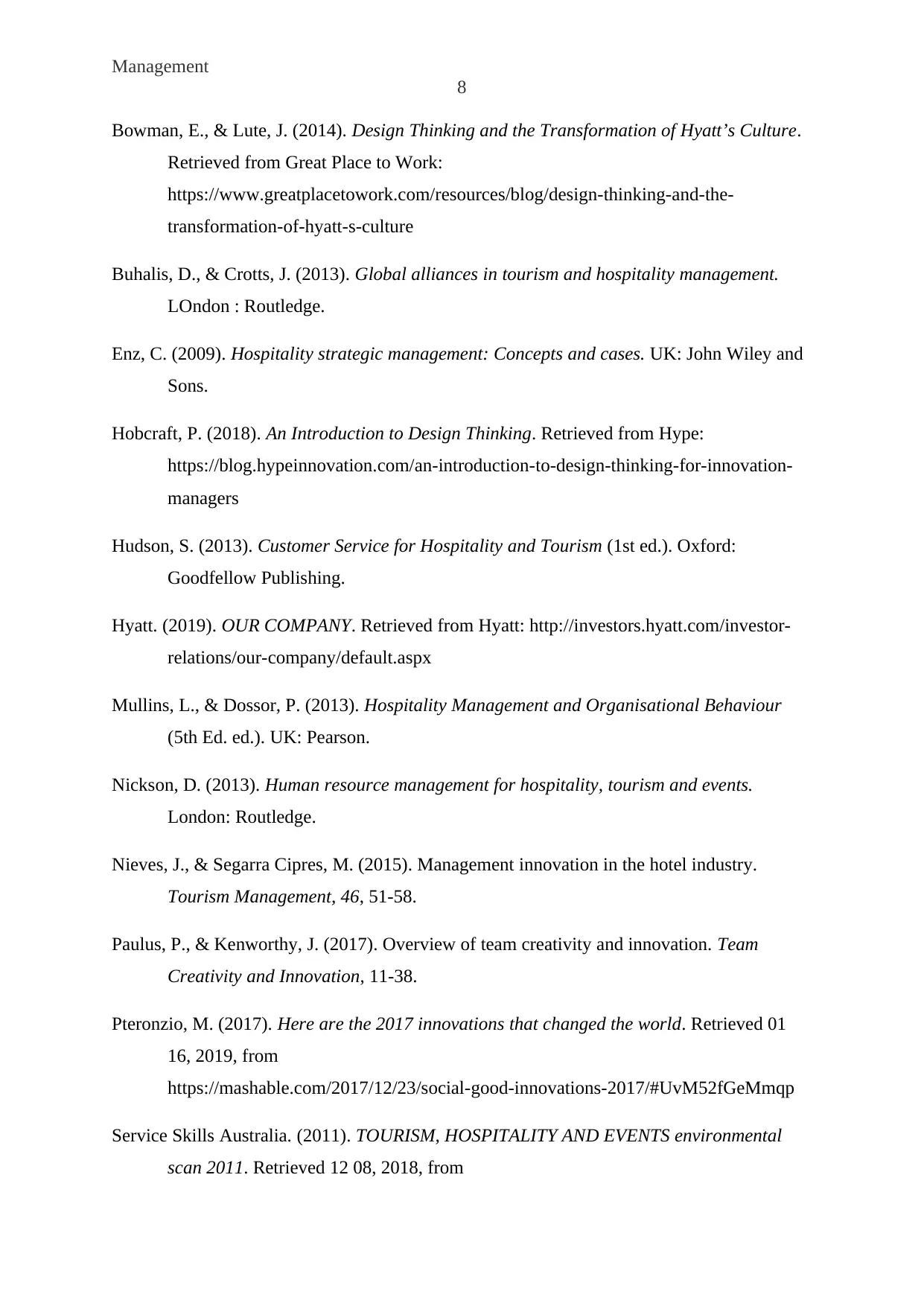
Management
8
Bowman, E., & Lute, J. (2014). Design Thinking and the Transformation of Hyatt’s Culture.
Retrieved from Great Place to Work:
https://www.greatplacetowork.com/resources/blog/design-thinking-and-the-
transformation-of-hyatt-s-culture
Buhalis, D., & Crotts, J. (2013). Global alliances in tourism and hospitality management.
LOndon : Routledge.
Enz, C. (2009). Hospitality strategic management: Concepts and cases. UK: John Wiley and
Sons.
Hobcraft, P. (2018). An Introduction to Design Thinking. Retrieved from Hype:
https://blog.hypeinnovation.com/an-introduction-to-design-thinking-for-innovation-
managers
Hudson, S. (2013). Customer Service for Hospitality and Tourism (1st ed.). Oxford:
Goodfellow Publishing.
Hyatt. (2019). OUR COMPANY. Retrieved from Hyatt: http://investors.hyatt.com/investor-
relations/our-company/default.aspx
Mullins, L., & Dossor, P. (2013). Hospitality Management and Organisational Behaviour
(5th Ed. ed.). UK: Pearson.
Nickson, D. (2013). Human resource management for hospitality, tourism and events.
London: Routledge.
Nieves, J., & Segarra Cipres, M. (2015). Management innovation in the hotel industry.
Tourism Management, 46, 51-58.
Paulus, P., & Kenworthy, J. (2017). Overview of team creativity and innovation. Team
Creativity and Innovation, 11-38.
Pteronzio, M. (2017). Here are the 2017 innovations that changed the world. Retrieved 01
16, 2019, from
https://mashable.com/2017/12/23/social-good-innovations-2017/#UvM52fGeMmqp
Service Skills Australia. (2011). TOURISM, HOSPITALITY AND EVENTS environmental
scan 2011. Retrieved 12 08, 2018, from
8
Bowman, E., & Lute, J. (2014). Design Thinking and the Transformation of Hyatt’s Culture.
Retrieved from Great Place to Work:
https://www.greatplacetowork.com/resources/blog/design-thinking-and-the-
transformation-of-hyatt-s-culture
Buhalis, D., & Crotts, J. (2013). Global alliances in tourism and hospitality management.
LOndon : Routledge.
Enz, C. (2009). Hospitality strategic management: Concepts and cases. UK: John Wiley and
Sons.
Hobcraft, P. (2018). An Introduction to Design Thinking. Retrieved from Hype:
https://blog.hypeinnovation.com/an-introduction-to-design-thinking-for-innovation-
managers
Hudson, S. (2013). Customer Service for Hospitality and Tourism (1st ed.). Oxford:
Goodfellow Publishing.
Hyatt. (2019). OUR COMPANY. Retrieved from Hyatt: http://investors.hyatt.com/investor-
relations/our-company/default.aspx
Mullins, L., & Dossor, P. (2013). Hospitality Management and Organisational Behaviour
(5th Ed. ed.). UK: Pearson.
Nickson, D. (2013). Human resource management for hospitality, tourism and events.
London: Routledge.
Nieves, J., & Segarra Cipres, M. (2015). Management innovation in the hotel industry.
Tourism Management, 46, 51-58.
Paulus, P., & Kenworthy, J. (2017). Overview of team creativity and innovation. Team
Creativity and Innovation, 11-38.
Pteronzio, M. (2017). Here are the 2017 innovations that changed the world. Retrieved 01
16, 2019, from
https://mashable.com/2017/12/23/social-good-innovations-2017/#UvM52fGeMmqp
Service Skills Australia. (2011). TOURISM, HOSPITALITY AND EVENTS environmental
scan 2011. Retrieved 12 08, 2018, from
⊘ This is a preview!⊘
Do you want full access?
Subscribe today to unlock all pages.

Trusted by 1+ million students worldwide
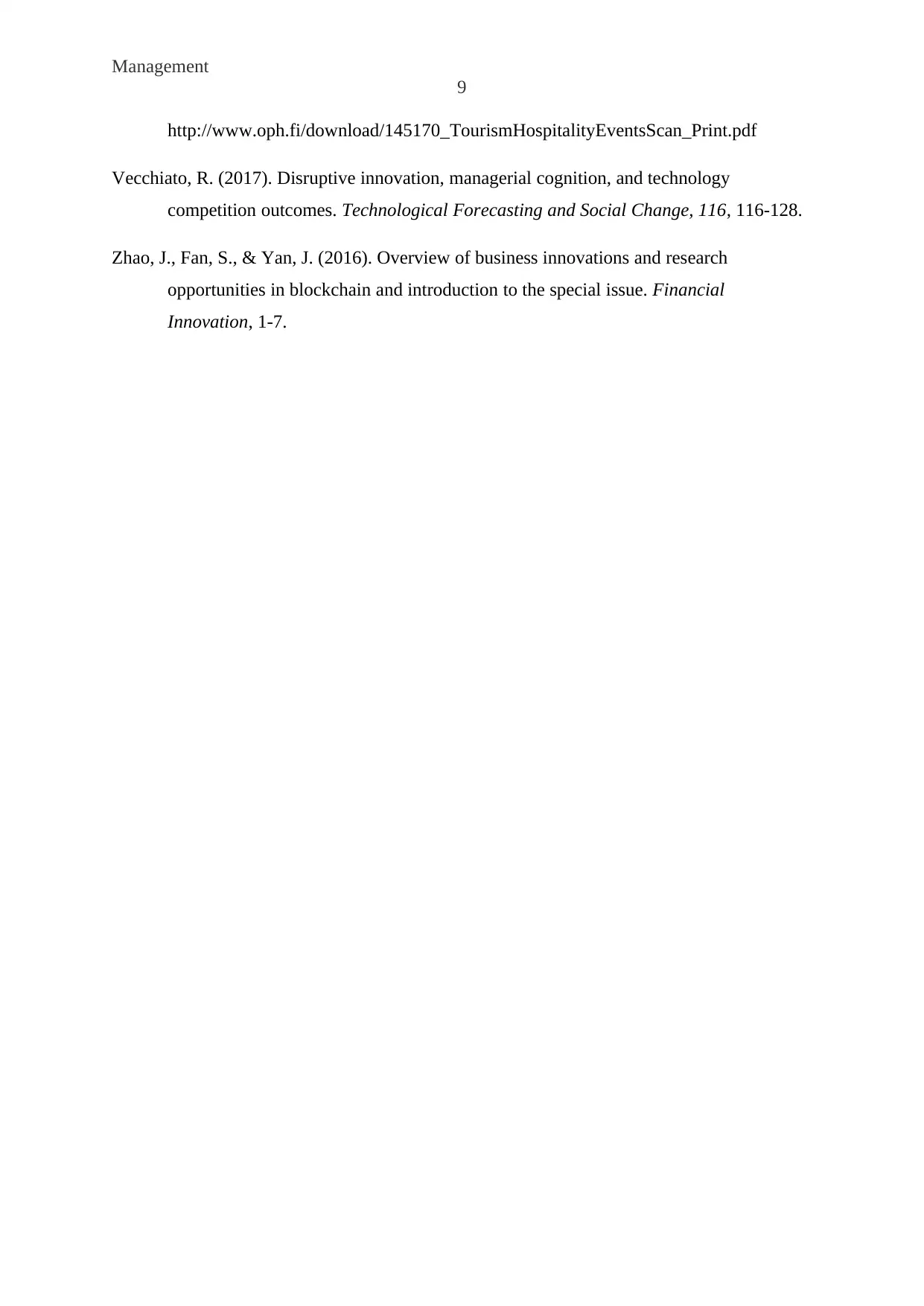
Management
9
http://www.oph.fi/download/145170_TourismHospitalityEventsScan_Print.pdf
Vecchiato, R. (2017). Disruptive innovation, managerial cognition, and technology
competition outcomes. Technological Forecasting and Social Change, 116, 116-128.
Zhao, J., Fan, S., & Yan, J. (2016). Overview of business innovations and research
opportunities in blockchain and introduction to the special issue. Financial
Innovation, 1-7.
9
http://www.oph.fi/download/145170_TourismHospitalityEventsScan_Print.pdf
Vecchiato, R. (2017). Disruptive innovation, managerial cognition, and technology
competition outcomes. Technological Forecasting and Social Change, 116, 116-128.
Zhao, J., Fan, S., & Yan, J. (2016). Overview of business innovations and research
opportunities in blockchain and introduction to the special issue. Financial
Innovation, 1-7.
1 out of 10
Your All-in-One AI-Powered Toolkit for Academic Success.
+13062052269
info@desklib.com
Available 24*7 on WhatsApp / Email
![[object Object]](/_next/static/media/star-bottom.7253800d.svg)
Unlock your academic potential
Copyright © 2020–2025 A2Z Services. All Rights Reserved. Developed and managed by ZUCOL.
